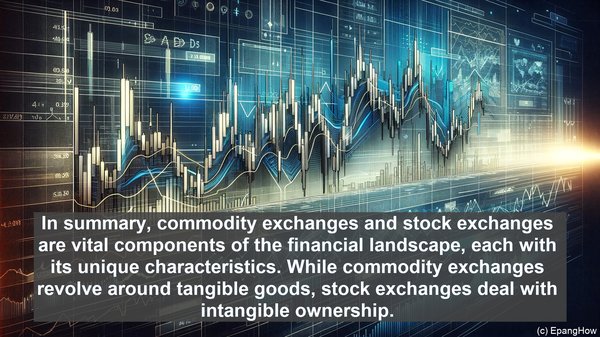Introduction: The World of Financial Exchanges
Hello and welcome! In the vast realm of finance, exchanges serve as the backbone of trading activities. Today, we’ll be exploring two prominent types: commodity exchanges and stock exchanges. While both facilitate the buying and selling of assets, they differ significantly in various aspects.
Assets: Tangible vs. Intangible
One of the primary distinctions lies in the assets traded. Commodity exchanges predominantly deal with tangible goods, such as agricultural products, metals, or energy resources. On the other hand, stock exchanges revolve around intangible assets, namely shares or stocks, representing ownership in a company.
Market Dynamics: Supply and Demand
The market dynamics also diverge between these exchanges. Commodity exchange prices are heavily influenced by factors like weather conditions, geopolitical events, or supply disruptions. In contrast, stock exchange prices are driven by a multitude of factors, including a company’s financial performance, industry trends, or even investor sentiment.
Trading Mechanisms: Spot and Futures
Another crucial aspect is the trading mechanisms. Commodity exchanges often involve spot trading, where immediate delivery of the asset occurs. However, they also offer futures contracts, enabling participants to buy or sell an asset at a predetermined price on a future date. Stock exchanges, primarily focused on shares, predominantly facilitate spot trading, with minimal involvement of futures contracts.

Regulatory Framework: Commissions and Exchanges
Regulations governing these exchanges also differ. Commodity exchanges are often subject to oversight by regulatory bodies, ensuring fair practices, price transparency, and risk mitigation. In contrast, stock exchanges are typically regulated by securities commissions, which monitor aspects like insider trading, market manipulation, or disclosure requirements.
Liquidity and Volatility: Varying Degrees
Liquidity, the ease of buying or selling an asset, and volatility, the price fluctuations, exhibit varying degrees in these exchanges. Stock exchanges, with their extensive market participation and high trading volumes, often offer higher liquidity. However, they can also experience greater volatility, influenced by factors like earnings reports or macroeconomic indicators. Commodity exchanges, while having lower liquidity, can witness significant price swings due to supply-demand dynamics or global events.

